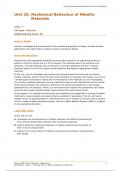Summary
Summary Unit 25 Mechanical Behaviours of Metallic Materials Unit Spec
- Course
- Institution
Unit 25 Mechanical Behaviour of Metallic Materials Unit Spec provides all the crucial information and requirements that you must include in your assignments in order to achieve Pass, Merit, and Distinction. Teachers also use these documents to identify what is required in the assignment this will g...
[Show more]



